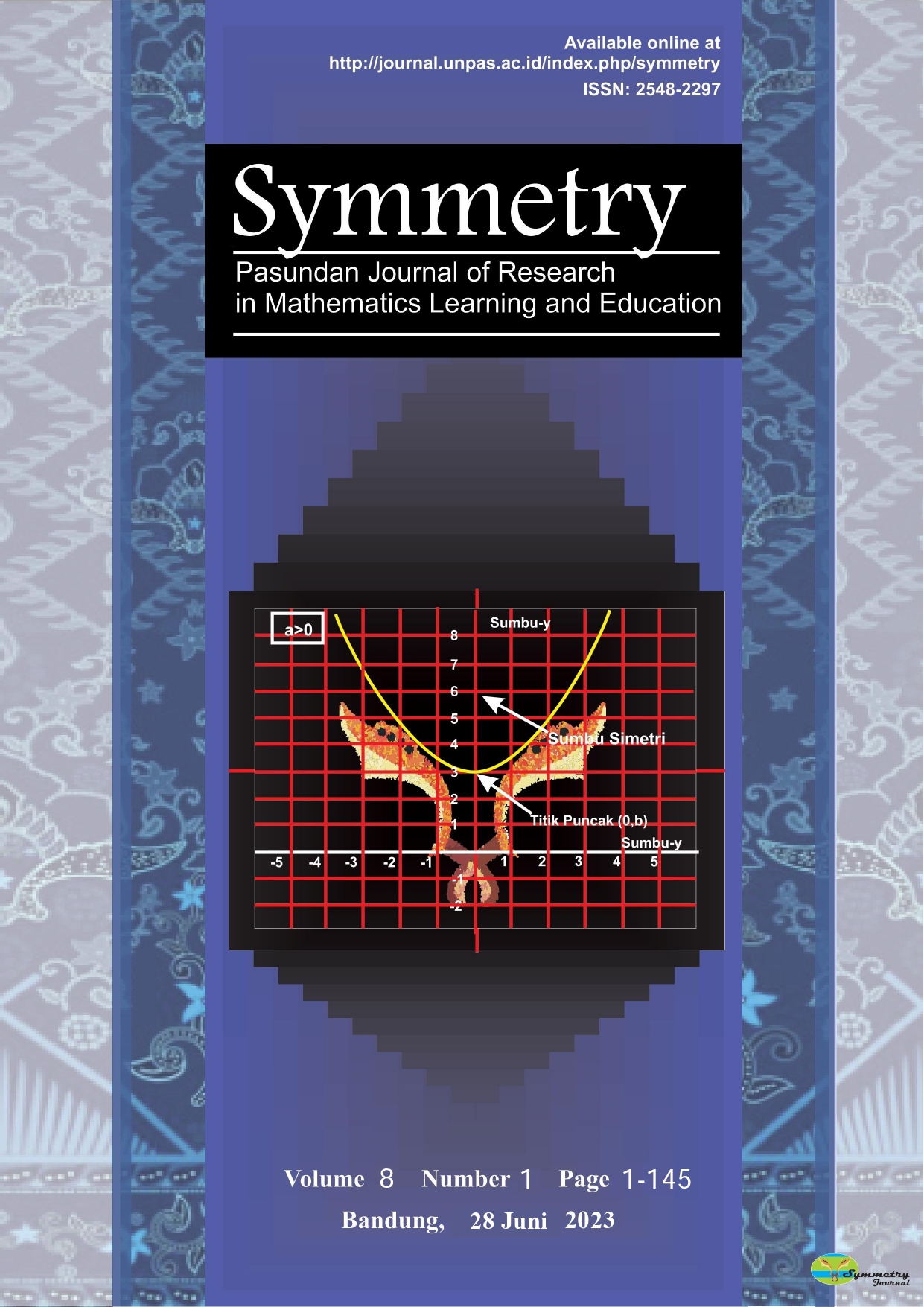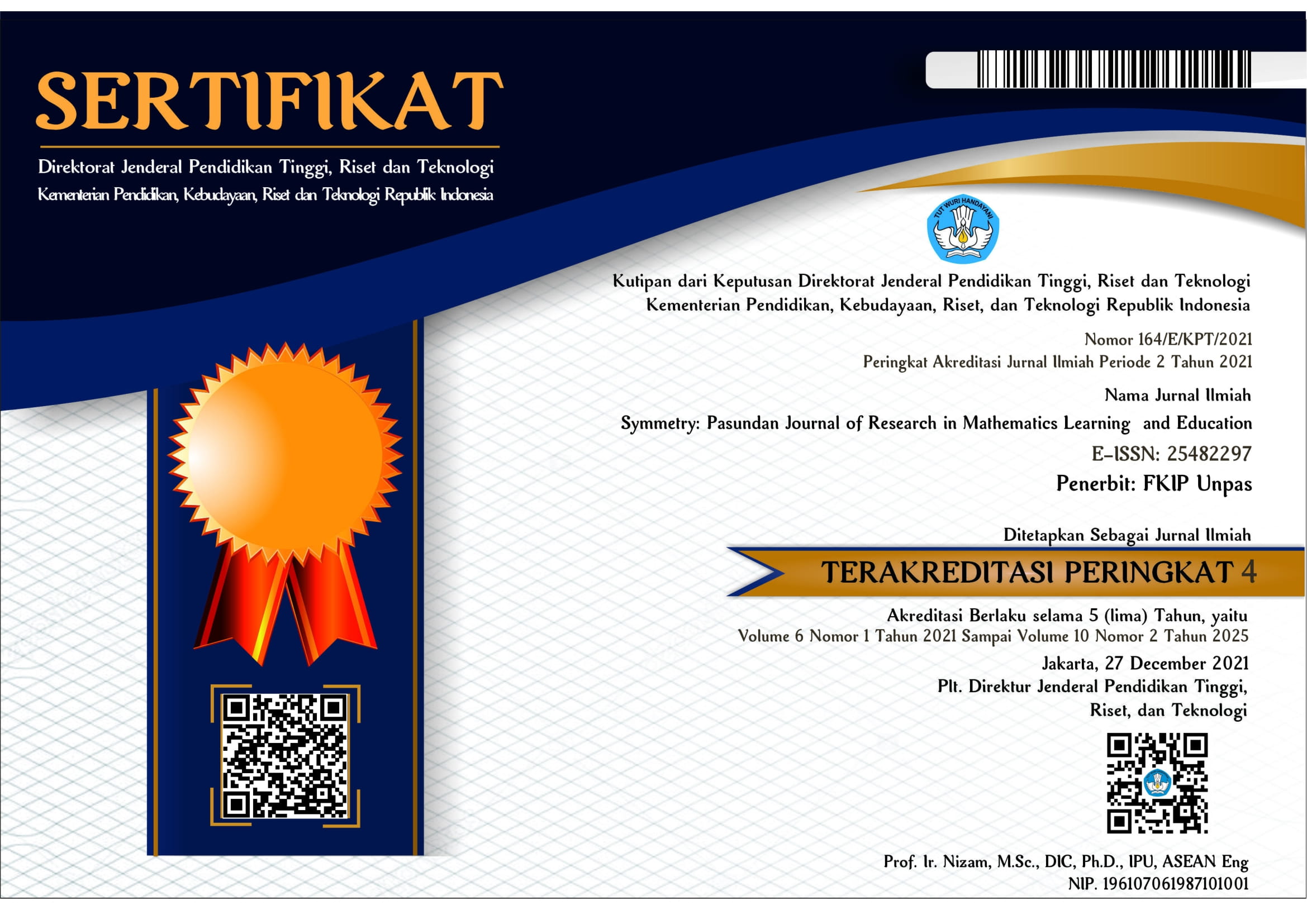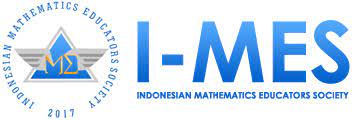PENGEMBANGAN PEMBELAJARAN DENGAN PENDEKATAN PMRI UNTUK MENINGKATKAN KEMAMPUAN LITERASI MATEMATIS BERBUDAYA LOKAL JAKARTA
DOI:
https://doi.org/10.23969/symmetry.v8i2.10809Keywords:
Pendidikan Matematika Realistik Indonesia, Penelitian Desain, Literasi Matematis, Budaya Lokal JakartaAbstract
The results of the preliminary study show that students' mathematical literacy skills on the topic probability was low. This is caused by teachers' conservative teaching methods and students who are not familiar with literacy matters. The presentation of opportunity material is not fully adequate to guide students in learning. This research aims to develop learning designs with a Realistic Mathematic Education (RME) approach with local Jakarta culture on opportunity material using the Gravemeijer and Cobb model which consists of three stages, namely experimental preparation), experimental implementation), and retrospective analysis. The research subject was Health Vocational School Mulia Karya Husada class XI. The learning design in question is a learning path known as Hypothetical Learning Trajectory (HLT). HLT is a learning flow consisting of learning objectives, learning activities, and learning process hypotheses to predict how students think and understanding will develop in the context of learning activities. The research results show that there was an increase in students mathematical literacy abilities.
Downloads
References
De Lange, J. (2003). Mathematics for Literacy In Numerasi. The National Counsil on Education And The Diciplines.
Empson, S. B. (2011). On the Idea of Learning Trajectory:Promises and Pitfalls. The Mathematics Enthusiast, 8(3). https://doi.org/10.54870/1551-3440.1229
Gravemeijer, K. (2012). Local instruction theories as means of support for teachers in reform mathematics education. In Hypothetical Learning Trajectories (pp. 105–128). Routledge.
Gravemeijer, K., & Cobb, P. (2013). Educational Design Research Part A: An introduction.
Netherlands Institute For Curriculum Development , 72–113. http://international.slo.nl/publications/edr/
Gravemeijer, K., & Terwel, J. (2000). Hans Freudenthal: A mathematician on didactics and curriculum theory. Journal of Curriculum Studies, 32(6), 777–796. https://doi.org/10.1080/00220270050167170
Gravemeijer, K., & Terwel, J. (2010). Hans Freudenthal: A mathematician on didactics and curriculum theory. Http://Dx.Doi.Org/10.1080/00220270050167170, 32(6), 777–796. https://doi.org/10.1080/00220270050167170
Hernandez, C. M., Morales, A., & Shroyer, G. (2013). The Development of A Model of Culturally Responsive Science and Mathematics Teaching. https://doi.org/10.1007/s11422-013-9544-1
Heuvel-Panhuizen, M. Van Den. (2003). The Didactical Use Of Models In Realistic Mathematics Education : An Example From A Longitudinal Trajectory On Percentage. Educational Studies In Mathematics, 9–35.
Hobri, H. (2009). Model-Model Pembelajaran Inovatif. Jember: FKIP Universitas Jember. Salinan SK Kepala BSAKN Kemdikbudristek tentang Capaian Pembelajaran, Pub. L. No. No 33/H/KR/2022 (2022).
Ladson-Billings, G. (1995). Toward a Theory of Culturally Relevant Pedagogy. American Educational Research Journal Fall, 32(3), 465–491.
OECD. (2019). PISA 2018 Mathematics Framework. www.oecd.org/pisa/
Oktiningrum, W., & Hartono, Y. (2016). Developing PISA-Like Mathematics Task With Indonesia Natural And Cultural Heritage As Context To Assess Students Mathematical Literacy. Journal on Mathematics Education, 7(1), 1–8.
Rodli. (2019). Pembelajaran Materi Peluang (Matematika) Melalui Kehidupan Nyata.
Jagaddhita, 1(2). http://eprints.ums.ac.id/59224/13/halaman
Sukmadinata, A. & N. S. (2010). Pengembangan Model Pembelajaran Terpadu Berbasis Budaya Untuk Meningkatkan Apresiasi Siswa Terhadap Budaya. Cakrawala Pendidikan, 2(2). https://doi.org/10.21831/CP.V2I2.339
Treffers, A. (1993). Wiskobas and Freudenthal realistic mathematics education. Educational Studies in Mathematics 1993 25:1, 25(1), 89–108. https://doi.org/10.1007/BF01274104
Utami, N., Sukestiyarno, Y. L., & Hidayah, I. (2019). Pentingnya Kemampuan Literasi dalam Menyelesaikan Soal Cerita Siswa Kelas XII IPA 3. Prosiding Seminar Nasional Matematika, 3, 626–633. https://journal.unnes.ac.id/sju/index.php/prisma/
Widyastuti, S., Pujiastuti, P., Widyastuti, N. S., Sd, P., Yogyakarta, T., & Yogyakarta, U. N. (2014). Pengaruh Pendidikan Matematika Realistik Indonesia (PMRI) Terhadap Pemahaman Konsep Dan Berpikir Logis Siswa. Jurnal Prima Edukasia, 2(2), 183–193. https://doi.org/10.21831/JPE.V2I2.2718
Wijaya, A., Elmaini, & Doorman, M. (2021). A learning trajectory for probability: A case of game-based learning. Journal on Mathematics Education, 12(1), 1–16. https://doi.org/10.22342/JME.12.1.12836.1-16
Yuniarti, R. (2022). Desain Pembelajaran Segi Empat dengan Pendekatan RME Pada Siswa SMP. Jurnal Riset Pendidikan Matematika Jakarta, 4(1), 89–101. https://doi.org/10.21009/jrpmj.v4i1.23028
Yurniwati, Y., & Handayani, R. (2019). Pengaruh Metode Realistic Mathematics Education terhadap Kemampuan Matematis Ditinjau dari Konsep Diri pada Siswa SD. JNPM (Jurnal Nasional Pendidikan Matematika), 3(1), 27. https://doi.org/10.33603/jnpm.v3i1.1020
Downloads
Published
Issue
Section
License
Copyright (c) 2023 Symmetry: Pasundan Journal of Research in Mathematics Learning and Education

This work is licensed under a Creative Commons Attribution 4.0 International License.
Hak Cipta sepenuhnya ditangan jurnal.




















